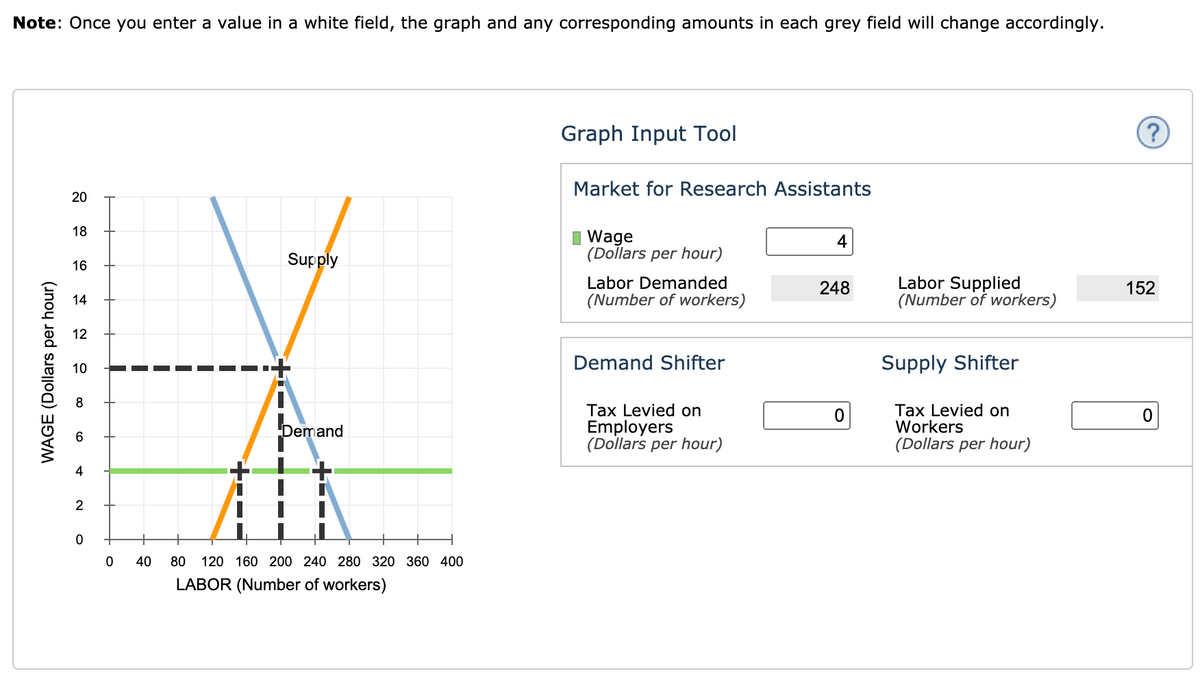The following graph shows the labor market for research assistants in the fictional country of Collegia. The equilibrium wage is $10 per hour, and the equilibrium number of research assistants is 200. Suppose the government has decided to institute a $2-per-hour payroll tax on research assistants and is trying to determine whether the tax should be levied on the employer, the workers, or both (such that half the tax is collected from each side). Use the graph input tool to evaluate these three proposals. Entering a number into the Tax Levied on Employers field (initially set at zero dollars per hour) shifts the demand curve down by the amount you enter, and entering a number into the Tax Levied on Workers field (initially set at zero dollars per hour) shifts the supply curve up by the amount
The following graph shows the labor market for research assistants in the fictional country of Collegia. The equilibrium wage is $10 per hour, and the equilibrium number of research assistants is 200. Suppose the government has decided to institute a $2-per-hour payroll tax on research assistants and is trying to determine whether the tax should be levied on the employer, the workers, or both (such that half the tax is collected from each side). Use the graph input tool to evaluate these three proposals. Entering a number into the Tax Levied on Employers field (initially set at zero dollars per hour) shifts the demand curve down by the amount you enter, and entering a number into the Tax Levied on Workers field (initially set at zero dollars per hour) shifts the supply curve up by the amount
Glencoe Algebra 1, Student Edition, 9780079039897, 0079039898, 2018
18th Edition
ISBN:9780079039897
Author:Carter
Publisher:Carter
Chapter10: Statistics
Section10.2: Representing Data
Problem 5GP
Related questions
Question
The following graph shows the labor market for research assistants in the fictional country of Collegia. The equilibrium wage is $10 per hour, and the equilibrium number of research assistants is 200.
Suppose the government has decided to institute a $2-per-hour payroll tax on research assistants and is trying to determine whether the tax should be levied on the employer, the workers, or both (such that half the tax is collected from each side).
Use the graph input tool to evaluate these three proposals. Entering a number into the Tax Levied on Employers field (initially set at zero dollars per hour) shifts the demand curve down by the amount you enter, and entering a number into the Tax Levied on Workers field (initially set at zero dollars per hour) shifts the supply curve up by the amount you enter. To determine the before-tax wage for each tax proposal, adjust the amount in the Wage field until the quantity of labor supplied equals the quantity of labor demanded. You will not be graded on any changes you make to this graph.
Note: Once you enter a value in a white field, the graph and any corresponding amounts in each grey field will change accordingly.
Graph Input Tool
|
Market for Research Assistants
|
|||||
|---|---|---|---|---|---|
|
Wage
(Dollars per hour)
|
|
||||
|
Labor Demanded
(Number of workers)
|
|
Labor Supplied
(Number of workers)
|
|
|
Demand Shifter
|
Supply Shifter
|
||||
|---|---|---|---|---|---|
|
Tax Levied on Employers
(Dollars per hour)
|
|
Tax Levied on Workers
(Dollars per hour)
|
|
For each of the proposals, use the previous graph to determine the new number of research assistants hired. Then compute the after-tax amount paid by employers (that is, the wage paid to workers plus any taxes collected from the employers) and the after-tax amount earned by research assistants (that is, the wage received by workers minus any taxes collected from the workers).
|
Tax Proposal
|
Quantity Hired
|
After-Tax Wage Paid by Employers
|
After-Tax Wage Received by Workers
|
|
|---|---|---|---|---|
|
Levied on Employers
|
Levied on Workers
|
(Number of workers)
|
(Dollars per hour)
|
(Dollars per hour)
|
|
(Dollars per hour)
|
(Dollars per hour)
|
|||
| 2 | 0 |
|
|
|
| 0 | 2 |
|
|
|
| 1 | 1 |
|
|
|
Suppose the government doesn't want to discourage employers from hiring research assistants and, therefore, wants to minimize the share of the tax paid by the employers. Of the three tax proposals, which is best for accomplishing this goal?
The proposal in which the entire tax is collected from workers
The proposal in which the tax is collected from each side evenly
The proposal in which the tax is collected from employers
None of the proposals is better than the others

Transcribed Image Text:Note: Once you enter a value in a white field, the graph and any corresponding amounts in each grey field will change accordingly.
Graph Input Tool
Market for Research Assistants
20
18
I Wage
(Dollars per hour)
4
Supply
16
Labor Supplied
(Number of workers)
Labor Demanded
248
152
14
(Number of workers)
12
Demand Shifter
Supply Shifter
10
Tax Levied on
Employers
(Dollars per hour)
Tax Levied on
Workers
(Dollars per hour)
Demand
4
40
80
120 160 200 240 280 320 360 400
LABOR (Number of workers)
WAGE (Dollars per hour)
Expert Solution
This question has been solved!
Explore an expertly crafted, step-by-step solution for a thorough understanding of key concepts.
This is a popular solution!
Trending now
This is a popular solution!
Step by step
Solved in 2 steps with 1 images

Recommended textbooks for you

Glencoe Algebra 1, Student Edition, 9780079039897…
Algebra
ISBN:
9780079039897
Author:
Carter
Publisher:
McGraw Hill

Algebra & Trigonometry with Analytic Geometry
Algebra
ISBN:
9781133382119
Author:
Swokowski
Publisher:
Cengage

Glencoe Algebra 1, Student Edition, 9780079039897…
Algebra
ISBN:
9780079039897
Author:
Carter
Publisher:
McGraw Hill

Algebra & Trigonometry with Analytic Geometry
Algebra
ISBN:
9781133382119
Author:
Swokowski
Publisher:
Cengage